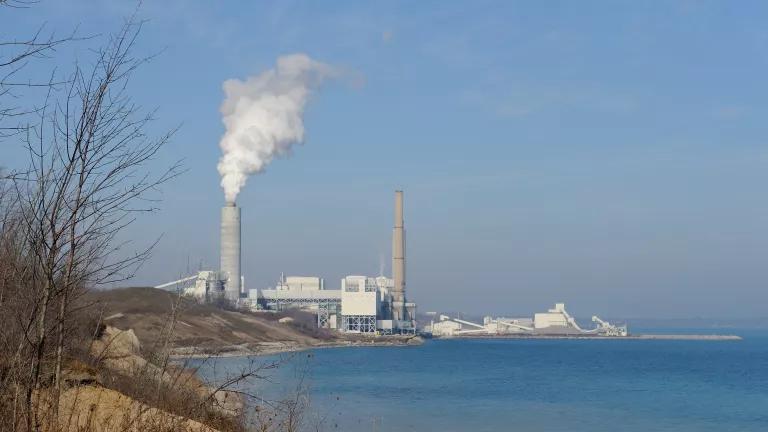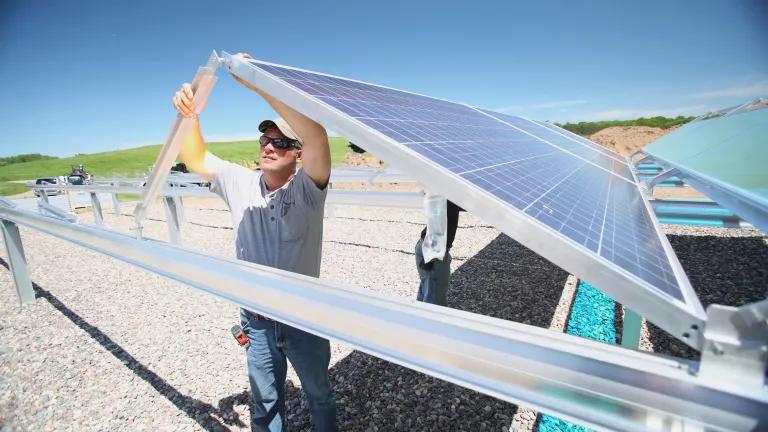Uneconomic Coal Costs MISO Ratepayers $1 Billion and Curtails 400 MW of Wind
New analysis from NRDC and Grid Strategies quantifies the renewable curtailment and emissions impact of running coal plants in the red.
Over the past five years, the Midwest grid operator, Midcontinent Independent System Operator (MISO), has increased the amount of wind power in the region by 64 percent. But what’s the use of building wind turbines if, in spite of their cost and climate advantages, they’re permanently playing second fiddle to coal?
In the United States, the MISO power grid has both the third-highest amount of installed wind capacity and the third-highest rate of wind curtailment, according to the U.S. Department of Energy. A new report from NRDC and Grid Strategies, The Consumer and Environmental Costs from Uneconomically Dispatching Coal Plants in MISO, indicates that many coal plants in MISO are crowding out cheaper, cleaner resources by operating at a financial loss. Between 2021 and 2023, uneconomic coal caused 3.8 million megawatt-hours (mwh) of wind to be pushed offline in MISO. That is equivalent to 400 megwatts (MW) of wind capacity, or enough clean energy to power all residential households in Des Moines for more than three years.
Our analysis found that by running coal when cheaper resources were available, customers across the MISO footprint were saddled with $1.1 billion in excess costs between 2021 and 2023.
The dashboard below illustrates the economic losses, curtailment impact, and excess pollution caused by uneconomic coal in MISO:
Why is this such a big problem in MISO? The majority of the 46 gigawatts (GW) of coal capacity in MISO is owned by vertically integrated utilities, which earn a guaranteed rate of return on their generation fleet and pass the operating costs on to customers. As a result, most utilities in MISO are indifferent to excessive fuel costs, and rate-regulated plants are much more likely to dispatch uneconomically. Therefore, expensive coal plants are more likely to be deemed “used and useful,” which is the usual standard by which regulators judge whether a power plant should keep operating and remain earning the utility a rate of return.
As the power grid has become dominated by lower-cost natural gas and, increasingly, renewables with zero marginal costs, the U.S. coal fleet has become largely uneconomic to operate during most hours. While coal plants may run uneconomically for a variety of reasons, our report analyzes all causes of uneconomic dispatch to assess the total renewable curtailment and increased emissions caused by the practice. Curtailment can occur for several reasons (e.g., transmission congestion, higher marginal price than the clearing price), and running uneconomic fossil units ultimately forces wind off the system.
The issue goes beyond the immediate impact of nudging out lower-cost, cleaner resources. Uneconomic dispatch also distorts market price signals for long-term investment and generator retirements. Money-losing coal plants artificially suppress energy prices and crowd out new, lower-cost resources like wind, solar, and highly flexible batteries. It’s a double whammy for MISO customers: Pay extra to run expensive coal and lose out on economic development from cleaner, cheaper power sources.
The good news is that several states in MISO have taken steps to address the problem. State commissions in Louisiana, Michigan, and Ohio have opened proceedings to investigate cases of uneconomic dispatch. In Louisiana, this resulted in a $125 million refund to customers who overpaid for the dispatch of a single coal power plant, Dolet Hills. In our report, we outline additional actions that MISO and states can take to combat uneconomic dispatch:
- State regulators can disallow utilities from recovering costs of uneconomic dispatch and reject inefficient fuel supply contracts for regulated utilities.
- MISO can improve the accuracy of generator bids and operating parameters to ensure they reflect generators’ true costs and flexibility.
- MISO can implement probabilistic unit commitment and new market products to address uncertainty in market commitments.
- MISO can create a voluntary multiday market to set price signals for expected supply and demand, improve resource commitment efficiency, and reduce overcommitment for reliability reasons that suppresses market prices.
- Together, state regulators and MISO can follow the independent market monitor’s recommendations to increase documentation and track of out-of-market commitment decisions to correct the root causes of uneconomic dispatch.
Customers have borne the extra cost of propping up money-losing coal plants for long enough. Uneconomic dispatch of coal crowds out lower-cost clean energy, driving up costs for customers and increasing the concentration of health-harming pollutants in the disadvantaged communities where most coal plants are located. States should follow each other’s lead and work with MISO to protect customers and fully utilize the cheap, clean power we have available today.


